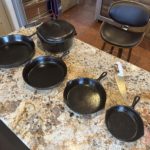The kitchen is the uncontested center of our home. We spend many hours there every day cooking meals, discussing the news of the day or passing in and out for a quick snack or cup of coffee. Over the years, we’ve become disillusioned with the local restaurant scene here in Albuquerque which features generally low quality food and high prices. While there are notable exceptions, we find that buying quality ingredients and cooking at home is much more satisfying, healthy and cost effective. While the kitchen is the center of the home, some would say the center of the kitchen is the cookware. I agree.
Cookware shysters appear on TV constantly with the newest and latest new innovation and claim that it’s the best ever made. Gotham Steel, Hex Clad, nano-titanium, and on and on. We recently decided to replace our All Clad “non-stick” Teflon cookware as the teflon had begun to depart from the pan – into the food, I presume. As I sorted through this old cookware, I reflected on my even older and most used cookware and decided to do a deep cleaning and re-seasoning on them.
Cast Iron. This set is several generations old (exactly how old, I don’t know) with each of the pieces responsible for helping to produce many thousands of meals large and small. Each one of these has its own character and set of aromas that I can only surmise are the cumulative result of having produced those meals. My re-seasoning process consists of a stiff scraper then a super-hot peanut (or canola) oil treatment. It’s such a great feeling to see the whole happy set after it gets the “spa” treatment.
The Dutch Oven – This large pot & lid usually get utilized for searing and finishing off large chickens or roasts. The high heating and searing quality on this piece with the heavy lid is very effective and it’s ability to finish meats at low heat to a tender delicacy further demonstrates the flexibility of cast iron.
The 13” Skillet works great for large packages of chicken thighs. We season and cook them “skin on” until tender. Then we set the thighs aside, remove the skins and cook them in their own oil until crunchy. These chicken skin cracklin’s are drained then chopped up and sprinkled back onto the thighs at mealtime and on other meals like soups that need a flavor and texture boost. When feeding 3 or more, this skillet with it’s large, flat cooking surface, gets used to cook off corn tortillas and assemble our famous “Turkey Pastor” tacos that feature a pineapple/tomatillo salsa that will take you right to the heart of Mexico City. We don’t eat fried stuff anymore, but in the old south U.S., these workhorses turned out many a fried chicken Sunday dinner.
The 10” Skillet is used for smaller meals, grilled sandwiches or tacos when only two are being fed. Anything the 13” can do, this one can too – but for a smaller crowd. Recently, I did a 4 pork chop with gravy dinner in this one that was empyrean.
The 8” Skillet typically gets used when I’m home alone and am grilling sandwiches or English muffins for one. Yes, even English muffins get toasted off in this skillet and the result is amazing.
The 6” Skillet is used almost exclusively for cooking fried eggs sunny side up. Especially, when the main meal is being assembled in one of the larger skillets – like when I make my “Green Chile Eggs Benedict” recipe. Scrambled eggs cooked in this little guy are really hard to beat.
These are a few uses, but these pans are all interchangeable and get used for almost anything you can think of. The joy of putting a meal together in one of these – practicing black magic, I call it – and adding to the collective soul built up out of past meals and past cooks and kitchens is priceless. My hope is that these pieces continue to work for some cook(s) after I’m gone and help to turn out soulful meals for many, many years into the future.

